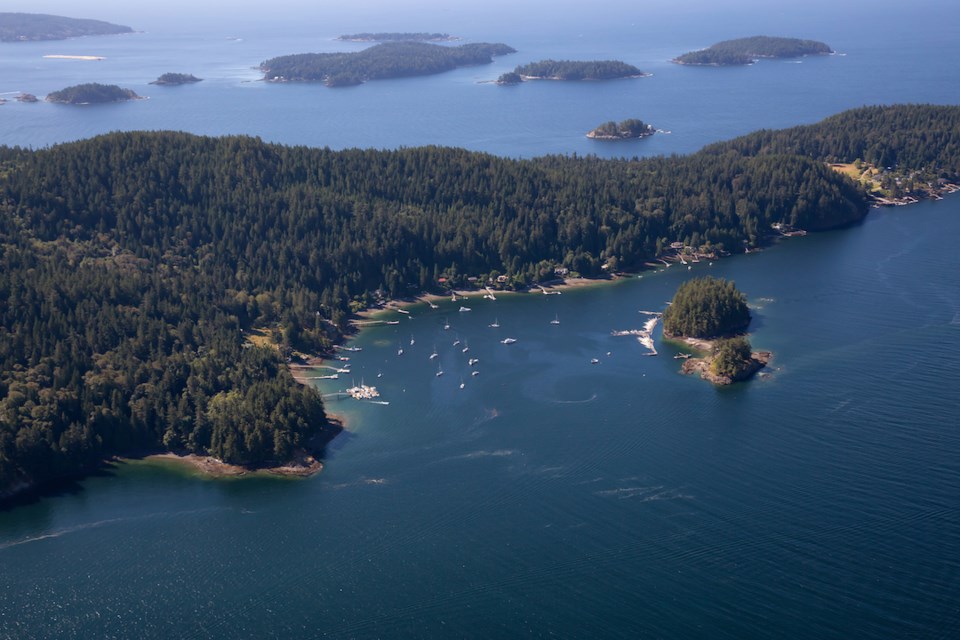Seven years in, the Islands Trust’s Keats Shoreline Protection Project continues to ply choppy waters.
Trustee Joe Bernardo issued an ultimatum at the Oct. 1 Gambier Island Trust Local Trust Committee meeting, proposing an exemption for additions to previously existing structures within the proposed shoreline development permit area. He said he couldn’t support the project going forward without this change. Staff meanwhile said such a change would trigger another public hearing.
While proposed Bylaws 153 and 154 had been on the agenda for second and third readings, that was too lofty a goal for the meeting, which ran out of time.
The bylaws
The bylaws establish a shoreline development permit area to protect the environment, ecosystems and biological diversity, as well as protect development from hazardous conditions, said staff.
Bylaw 153 would amend the Official Community Plan (OCP) to create a new shoreline development permit area, extending upland 15 metres from the natural boundary of the sea, the foreshore area and seaward 100 metres from the natural boundary.
Bylaw 154 would amend the Land Use Bylaw to regulate structures permitted within the setback, increase setbacks between existing docks and lot lines, reduce the maximum float area of private docks and shared docks, reduce ramp width and reduce the maximum area of floats or ramps permitted in the area.
None of the regulations would be retroactively applied.
Like many islands in B.C., Keats Island faces unique circumstances. The setback on Keats Island is seven and a half metres, instead of the usual 15 to 30, and is one of the smallest in the Trust Area, Island Planner Marlis McCargar explained at the project’s public hearing in July.
Additions within the setback
Bernardo’s proposed resolution launched the meeting into a lengthy debate. Bernado, who lives on Keats Island, proposed that the land use bylaw amendment be changed to allow additions to pre-existing buildings, structures and utilities situated between 7.5 meters and 15 meters from the natural boundary of the sea. Stipulations include that (1) no part of the work may involve the use of earth-moving machinery or the removal of native tree species, (2) the addition does not exceed 50 square meters, 500 square feet in area, and must be erected on previously disturbed land, (3) the work does not result in environmental degradation of any kind, anywhere within DP-3 (Shoreline) or to the ecology of the foreshore.
Bernado said he was fine going forward to the fourth reading if his resolution was passed and was “procedurally feasible” under the LTC’s authority. However, he said he could not support the bylaw if his proposed changes were not accepted.
Bernado reiterated sentiments shared at the public hearing, those of speakers who criticized the bylaws as a bad fit for the community or pleaded to the LTC to make changes, he added that due to Island Trust communication processes, the community is not up to date on the project.
Bernado said people in the community believe the supporting scientific justification of the bylaws remains insufficient or dubious, that there's no rational justification on environmental grounds for imposing a permitting requirement for construction on land that's already been disturbed and the need for additional shoreline regulations has been overstated.
“I can't support a bylaw that imposes a burden, a regulatory burden and a requirement for a development permit that hasn't been justified on the basis of environmental protection,” said Bernardo. “The evidence isn't there.”
McCargar said this would likely be considered a major project change and trigger another public hearing.
Trustee Kate-Louise Stamford said she could not support Berardo’s resolution as it was written.
“Part of my concern here today is I've been given an ultimatum, take it or leave it after everything we've done, now I'm being told that's it,” Stamford said. “This will help people with larger lots, I don't think it's going to help people with the small, really difficult lots that we're going to have to deal with on a one-off basis. And they deserve that kind of attention.”
McCargar pointed out out that they are post-public hearing and that no new evidence or material will be brought forward by staff unless the LTC decides to hold an additional public hearing. She added there is no more funding or staff time available for the shoreline project in this fiscal year.
Bernardo then moved to table his proposed motion and the LTC voted to address the resolution at their next meeting.
Amendments
While no readings were passed, the committee did pass a number of minor amendments to the bylaws.
Approved amendments for Bylaw 153 included adding subsection numbers to areas where it was missing and including “construction” as a development activity.
Bylaw 154 saw numbering errors addressed, clarifications on residential dwellings served by docks, and removal of a section clarifying that “Docks should be designed to avoid interfering with public movement along the foreshore.” Amendments were moved and carried by the LTC.
Jordan Copp is the Coast Reporter’s civic and Indigenous affairs reporter. This reporting beat is made possible by the Local Journalism Initiative.
Words missing in article? Your adblocker might be preventing hyperlinked text from appearing.



